
The IAI RQ-5 Hunter unmanned aerial vehicle (UAV) was originally intended to serve as the United States Army's Short Range UAV system for division and corps commanders. It took off and landed on runways. It used a gimbaled EO/IR sensor to relay its video in real time via a second airborne Hunter over a C-band line-of-sight data link. The RQ-5 is based on the Hunter UAV that was developed by Israel Aerospace Industries.

The Alliant RQ-6 Outrider unmanned aerial vehicle (UAV) was designed to provide near-real-time reconnaissance, surveillance, and target acquisition information to United States Marine Corps air/ground task forces, United States Army brigades, and deployed United States Navy units that was small enough for an entire system to be contained on two Humvees and trailer and transported on a single C-130 Hercules cargo aircraft.

The Avro 691 Lancastrian was a British and Canadian passenger and mail transport aircraft of the 1940s and 1950s developed from the Avro Lancaster heavy bomber. The Lancastrian was basically a modified Lancaster bomber without armour or armament and with the gun turrets replaced by streamlined metal fairings, including a new nose section. The initial batch was converted directly from Lancasters; later batches were new builds.

The Bateleur is an unmanned aerial vehicle (UAV) prototype designed and built by Denel Dynamics. It has been designed as a MALE UAV, with its primary role being surveillance, with a secondary signals intelligence capability.

The Vultee XA-41 was originally ordered as a dive bomber. After combat experience led the Army Air Corps to believe dive-bombers were too vulnerable to enemy fighters, the contract was amended to change the role to low-level ground attack. Although the XA-41 was a potent weapons system, the design was overtaken by more advanced technology, and never entered production.
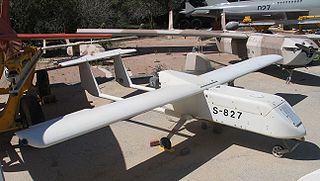
The Tadiran Mastiff is a battlefield UAV built by Tadiran Electronic Industries, regarded by some military historians as the world's first modern military drone.

The General Atomics Altus is an unmanned aerial vehicle, designed for scientific research, built by General Atomics Aeronautical Systems (GA-ASI).

The Agusta AZ.8L, or Agusta-Zappata AZ.8L, was an Italian airliner prototype first flown on 9 June 1958. It was of conventional low-wing monoplane configuration with tricycle undercarriage and all-metal construction. Filippo Zappata's design grew out of a twin-engined transport designated AZ.1 that was never built.

The Darmstadt D-22 was a sports-plane of Germany, designed and built by Akaflieg of Technische Universität Darmstadt.
Shahbal is an unmanned aerial vehicle (UAV) designed by a group of aerospace engineers at Sharif University of Technology.

The M 17 was a German single-engine high-wing sports monoplane. It was designed by Willy Messerschmitt in 1925 in Bamberg. This aircraft won many competitions and allowed Willy Messerschmitt to build his first factory.
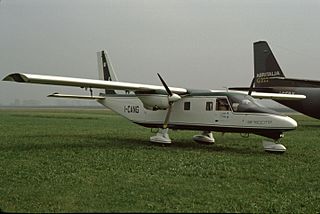
The Vulcanair SF.600 Canguro was a feederliner developed in Italy in the late 1970s. Despite a number of attempts to put the aircraft into series production, only a small number were ever built. The Canguro was a high-wing cantilever monoplane of conventional configuration with a fuselage of rectangular cross-section and a high-set tail. The tricycle undercarriage was not retractable, and its main units were carried on sponsons on the fuselage sides. SIAI Marchetti provided funding towards the construction of the prototype, and constructed this aircraft at the former Aviamilano plant. After flight testing proved positive, the type was put on sale, but failed to attract buyers in any number, even when the original piston engines were exchanged for turboprops and retractable undercarriage was offered as an option.
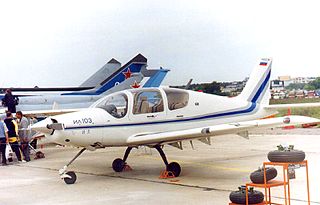
The Ilyushin Il-103 is a single-engine, low-wing training aircraft developed by the Ilyushin Design Bureau that started in 1990 in the Soviet Union. The aircraft is now produced in Russia. It was the first Russian aircraft to achieve Federal Aviation Administration certification, in 1998, for sales in the United States.
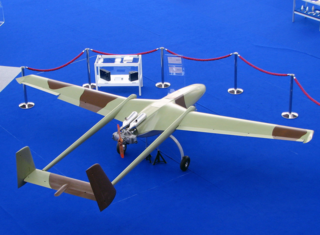
The PEGAZ 011 is a medium-range tactical UAV for day and night attack, reconnaissance and surveillance missions, target acquisition and designation developed by Military Technical Institute in Serbia and produced by Utva Aviation Industry, subsidiary of Yugoimport SDPR. Its flight autonomy is over 12 hours, and it sends data from the height of 6,000 m. Powered by a two-cylinder boxer type of engine with 32 kW (43 HP), it reaches the maximum flight speed of 200 km/h. The PEGAZ has a maximum weight of 240 kg, including about 50 kg of reconnaissance/surveillance equipment. It is 5.4 m long with a wingspan of 6.34 m. It takes off automatically from improvised runways and performs tasks along pre-programmed flight. There are two hardpoints for optional air-to-surface missiles for attack variant.
The Harmon Der Donnerschlag is an American homebuilt aircraft that was designed and produced by Harmon Engineering of Howe, Texas. The aircraft was intended for amateur construction.
The Amax Sport 1700 is an Australian homebuilt aircraft that was designed and produced by Amax Engineering of Donvale, Victoria. When it was available the aircraft was supplied as a kit or in the form of plans for amateur construction.
The Bagalini Baganfibio is an Italian homebuilt flying boat that was designed by Marino Bagalini. The aircraft is supplied in the form of plans for amateur construction.

AirStrato is a solar powered medium-sized unmanned aerial vehicle that was being developed by ARCAspace. There were two variants planned, AirStrato Explorer with a target flight ceiling of 18,000 m and AirStrato Pioneer with a target flight ceiling of 8000 m. It was planned to carry a 45 kg payload consisting of surveillance equipment, scientific instruments or additional battery pods for extended autonomy. The first prototype maiden flight took place on February 28, 2014. It was equipped with a fixed landing gear. Two more prototypes were constructed that lacked a landing gear. Instead ARCA opted for a pneumatic catapult as a launcher and landing skids and a recovery parachute for landing. Both prototypes performed take-off and landing testing and low altitude flights.
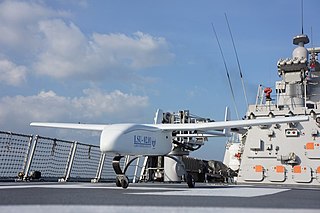
The LAPAN LSU-02 is an unmanned aerial vehicle (UAV) developed by the Lembaga Penelitian dan Penerbangan Nasional (LAPAN) of Indonesia. It was developed in 2012 for both civilian and military purposes. The Indonesian military classifies it as a tactical UAV because of its ability to fly over long ranges for its size. It broke an Indonesian record for longest ranged UAV built locally.
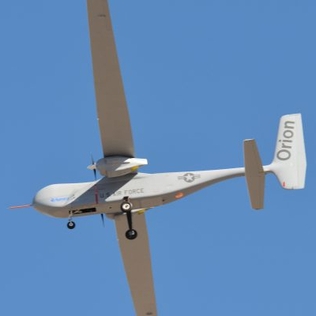
The Orion is a Medium-altitude long-endurance unmanned aerial vehicle (UAV) developed by Aurora Flight Sciences.
















